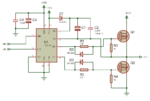abhishek.2138
Full Member level 2
In IGBT/MOSFET H-bridge for AC drive or inverter power circuit, generally 1N4148 diodes are connected to gate terminals for adjusting the turn-off time.
How to calculate the diode resistance in this case?? Circuit is attached...(Here resistances for D2 & D3)
Can we use 1N4148 in place of UF4007?
I calculated the resistance as per the diode formula , but it comes in milliohms. I have doubt about the calculated values...
References-- **broken link removed**
**broken link removed**
Please help...
How to calculate the diode resistance in this case?? Circuit is attached...(Here resistances for D2 & D3)
Can we use 1N4148 in place of UF4007?
I calculated the resistance as per the diode formula , but it comes in milliohms. I have doubt about the calculated values...
References-- **broken link removed**
**broken link removed**
Please help...
